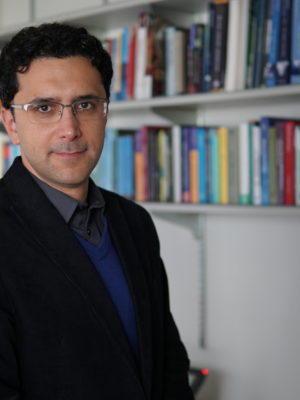Dr. Ali Rowhani-Rahbar: Examining the Effectiveness of Extreme Risk Laws

2.22.2021
Safety in Numbers
Welcome to Everytown Research & Policy’s Safety in Numbers blog series, where we will invite leading experts in the growing field of injury and safety prevention to present their rigorous research in clear, user-friendly language on a regular basis. Our goal is to share the latest developments, answer important questions, and stimulate evidence-based conversations on gun violence prevention in which all of us can participate. If you have a topic you want to hear more about, please feel free to suggest it at: [email protected].
Sarah Burd-Sharps, Director of Research
Note: The views, opinions, and content expressed in this post do not necessarily reflect the views, opinions, or policies of Everytown for Gun Safety Support Fund.
Dr. Ali Rowhani-Rahbar was “profoundly impacted” by the Sandy Hook School mass shooting. After the event, he shifted his research to focus on firearm injury and violence research. He strives to approach gun violence as the major public safety and public health problem that it is.
“Research on firearm injury and violence has been one of the most rewarding experiences of my career because it has specific, and often immediate, policy, practice, and program implications,” Dr. Rowhani-Rahbar said. “The common goal is to prevent injuries and save lives.”
One of the focuses of his research is Extreme Risk laws. These laws allow family members and law enforcement to petition a court for an order, often known as an extreme risk protection order (ERPO) to temporarily prevent someone in crisis from accessing guns. This gun violence prevention legal tool can help de-escalate emergency situations and prevent gun suicide, mass shootings, and other forms of gun violence. Dr. Rowhani-Rahbar and his research group develop evidence that will help inform new policies and use data to better understand the impact of those policies.
Learn more about Dr. Rowhani-Rahbar, in his own words:
I was born and raised in Iran. After completing medical school, I moved to the United States in 2003 to study public health. I was always intrigued by the power of social and systems approaches to promote health and prevent harm, and as such, chose to continue my education in epidemiology. During my masters program at Yale University, doctoral program at the University of Washington, and postdoctoral training at Stanford University and Kaiser Permanente, I focused on the epidemiology of vaccine-preventable diseases. I joined the University of Washington as a faculty member in 2012 and began my teaching and research in late September that year.
Less than three months into teaching my first class, the mass shooting at Sandy Hook School occurred. That event, in many ways, changed the lives of many individuals in this country. I was no exception. My career trajectory was changed and formed by the tragedy. Frequent exposures to the coverage of firearm injury and violence in the media was a part of “culture shock” that I had experienced since moving to the US; yet, I had not formally become involved in this line of research. Immediately after the Sandy Hook tragedy, I began working on firearm injury and violence.
Studies have shown that Extreme Risk laws are associated with a reduction in the risk of suicide.
One of the most innovative legal tools with great potential to prevent injuries and save lives are Extreme Risk laws (sometimes referred to as gun violence restraining orders, “red flag” laws, risk-based laws, etc.). These laws are designed to protect individuals from dangerous behavior such as firearm suicide, threatening to harm others with a gun, and mass shootings. As of February 2021, 19 states and Washington, DC have enacted Extreme Risk laws. These laws allow certain individuals (i.e., petitioners) to petition the court for an ERPO to temporarily restrict access to firearms among people (i.e., respondents) who display dangerous behavior to themself or others. Studies from the two states that enacted these laws first (Connecticut and Indiana) have shown them to be associated with reductions in the risk of suicide. In all other jurisdictions, these laws went into effect in recent years starting in 2016. As such, there is tremendous opportunity to learn about all aspects of these laws.
States with Extreme Risk Laws
In September 2020, we published results from the first statewide study of ERPOs in Washington. We learned that its uptake varied across counties. We also found that the petitioner reported prior domestic violence perpetration, substance use, and criminal justice system involvement by the respondent in 24 percent, 47 percent, and 37 percent of cases, respectively. Of all respondents, 62 percent had a history of thinking of or attempting to take their own life according to the petitioner. As part of the ERPO process, the court ordered a mental health evaluation in 30 percent of cases. Other county-wide or statewide studies of ERPO laws are emerging. We have also studied the use of ERPOs within specific populations such as older adults or those with cognitive decline.
New studies will examine the effectiveness of Extreme Risk laws.
There is still more to learn about Extreme Risk laws. As part of a multi-site study of these laws funded by the National Collaborative on Gun Violence Research, other colleagues and our team are now examining the characteristics of petitioners and respondents, the nature of the dangerous behavior and precipitating events that led to filing an ERPO, and violence-related outcomes across six different states. In the next couple of years, this study will provide a wealth of information on several aspects of Extreme Risk laws across a diverse panel of jurisdictions in the country. Future studies of these laws should examine their implementation, process measures, and a range of outcomes at the intersection of healthcare and criminal justice systems to provide information on their effectiveness.
A research gap: Implicit bias could affect the implementation and enforcement of extreme risk protection orders.
ERPOs are civil, not criminal, court orders and the individuals to date who request them have been overwhelmingly law enforcement. While every effort is made to respect one’s legal rights, it is conceivable that implicit bias could affect any part of the ERPO process, from law enforcement serving and enforcing the order to judges granting the court order. Considering the nascent nature of research on Extreme Risk laws, we currently lack robust evidence to examine and quantify potential racial bias implications of ERPOs. Future qualitative research could go a long way toward improving our understanding of the circumstances surrounding ERPOs and ways to improve the processes associated with them.
Policy and non-policy interventions are needed to reduce the risk of firearm-related injury.
Considering the large number of firearms in the US, we must use a range of policy and non-policy options to reduce the risk of firearm injury and harm while respecting law-abiding gun owners. A single solution for the public safety and public health problem of firearm injury and violence does not exist. But, advocating, promoting, and implementing tools and safety measures, such as Extreme Risk laws, may serve as one effective component of efforts toward turning today’s vision on reducing firearm injury and violence into tomorrow’s reality.
About Dr. Rowhani-Rahbar
Ali Rowhani-Rahbar, MD, MPH, PhD is the Bartley Dobb Endowed Associate Professor for the Study and Prevention of Violence in the Department of Epidemiology at the University of Washington. He is the Co-Director of the Firearm Injury & Policy Research Program and Leader of the Violence Prevention Section at Harborview Injury Prevention & Research Center. The overarching goal of his research is to inform programs, practices, and policies that prevent the occurrence, reduce the lethality, and stop the recurrence of interpersonal violence and self-directed harm. His epidemiologic studies have spanned across multiple forms of violence with a specific focus on firearm-related injury and harm.




